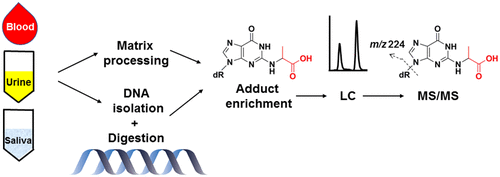当前位置:
X-MOL 学术
›
Chem. Res. Toxicol.
›
论文详情
Our official English website, www.x-mol.net, welcomes your feedback! (Note: you will need to create a separate account there.)
DNA Adducts as Biomarkers To Predict, Prevent, and Diagnose Disease-Application of Analytical Chemistry to Clinical Investigations.
Chemical Research in Toxicology ( IF 4.1 ) Pub Date : 2019-12-18 , DOI: 10.1021/acs.chemrestox.9b00295 Carlos Hernandez-Castillo 1 , John Termini 1 , Sarah Shuck 1
Chemical Research in Toxicology ( IF 4.1 ) Pub Date : 2019-12-18 , DOI: 10.1021/acs.chemrestox.9b00295 Carlos Hernandez-Castillo 1 , John Termini 1 , Sarah Shuck 1
Affiliation

|
Characterization of the chemistry, structure, formation, and metabolism of DNA adducts has been one of the most significant contributions to the field of chemical toxicology. This work provides the foundation to develop analytical methods to measure DNA adducts, define their relationship to disease, and establish clinical tests. Monitoring exposure to environmental and endogenous toxicants can predict, diagnose, and track disease as well as guide therapeutic treatment. DNA adducts are one of the most promising biomarkers of toxicant exposure owing to their stability, appearance in numerous biological matrices, and characteristic analytical properties. In addition, DNA adducts can induce mutations to drive disease onset and progression and can serve as surrogate markers of chemical exposure. In this perspective, we highlight significant advances made within the past decade regarding DNA adduct quantitation using mass spectrometry. We hope to expose a broader audience to this field and encourage analytical chemistry laboratories to explore how specific adducts may be related to various pathologies. One of the limiting factors in developing clinical tests to measure DNA adducts is cohort size; ideally, the cohort would allow for model development and then testing of the model to the remaining cohort. The goals of this perspective article are to (1) provide a summary of analyte levels measured using state-of-the-art analytical methods, (2) foster collaboration, and (3) highlight areas in need of further investigation.
中文翻译:

DNA加合物作为预测,预防和诊断疾病的生物标志物-分析化学在临床研究中的应用。
DNA加合物的化学,结构,形成和代谢的表征一直是化学毒理学领域最重要的贡献之一。这项工作为开发分析方法以测量DNA加合物,定义它们与疾病的关系以及建立临床测试奠定了基础。监测环境和内源性毒物的暴露可以预测,诊断和跟踪疾病,并指导治疗。DNA加合物由于其稳定性,在多种生物基质中的出现以及独特的分析特性,因此是有毒物质暴露最有前途的生物标记之一。另外,DNA加合物可以诱导突变,从而驱动疾病的发作和发展,并可以充当化学暴露的替代标记。从这个角度来看,我们着重介绍了过去十年中在使用质谱技术进行DNA加合物定量方面取得的重大进展。我们希望让更多的读者接触该领域,并鼓励分析化学实验室探索特定的加合物如何与各种病理相关。开展临床测试以测量DNA加合物的限制因素之一是队列规模。理想情况下,同类群组将允许模型开发,然后对其余同类群组进行模型测试。本文的目的是(1)提供使用最新分析方法测得的分析物含量的摘要,(2)促进合作,以及(3)突出需要进一步研究的领域。我们希望让更多的读者接触该领域,并鼓励分析化学实验室探索特定的加合物如何与各种病理相关。开展临床测试以测量DNA加合物的限制因素之一是队列规模。理想情况下,同类群组将允许模型开发,然后对其余同类群组进行模型测试。本文的目的是(1)提供使用最新分析方法测得的分析物含量的摘要,(2)促进合作,以及(3)突出需要进一步研究的领域。我们希望让更多的读者接触该领域,并鼓励分析化学实验室探索特定的加合物如何与各种病理相关。开展临床测试以测量DNA加合物的限制因素之一是队列规模。理想情况下,同类群组将允许模型开发,然后对其余同类群组进行模型测试。本文的目的是(1)提供使用最新分析方法测得的分析物含量的摘要,(2)促进合作,以及(3)突出需要进一步研究的领域。该队列将允许模型开发,然后对其余队列进行模型测试。本文的目的是(1)提供使用最新分析方法测得的分析物含量的摘要,(2)促进合作,以及(3)突出需要进一步研究的领域。该队列将允许模型开发,然后对其余队列进行模型测试。本文的目的是(1)提供使用最新分析方法测得的分析物含量的摘要,(2)促进合作,以及(3)突出需要进一步研究的领域。
更新日期:2019-12-19
中文翻译:

DNA加合物作为预测,预防和诊断疾病的生物标志物-分析化学在临床研究中的应用。
DNA加合物的化学,结构,形成和代谢的表征一直是化学毒理学领域最重要的贡献之一。这项工作为开发分析方法以测量DNA加合物,定义它们与疾病的关系以及建立临床测试奠定了基础。监测环境和内源性毒物的暴露可以预测,诊断和跟踪疾病,并指导治疗。DNA加合物由于其稳定性,在多种生物基质中的出现以及独特的分析特性,因此是有毒物质暴露最有前途的生物标记之一。另外,DNA加合物可以诱导突变,从而驱动疾病的发作和发展,并可以充当化学暴露的替代标记。从这个角度来看,我们着重介绍了过去十年中在使用质谱技术进行DNA加合物定量方面取得的重大进展。我们希望让更多的读者接触该领域,并鼓励分析化学实验室探索特定的加合物如何与各种病理相关。开展临床测试以测量DNA加合物的限制因素之一是队列规模。理想情况下,同类群组将允许模型开发,然后对其余同类群组进行模型测试。本文的目的是(1)提供使用最新分析方法测得的分析物含量的摘要,(2)促进合作,以及(3)突出需要进一步研究的领域。我们希望让更多的读者接触该领域,并鼓励分析化学实验室探索特定的加合物如何与各种病理相关。开展临床测试以测量DNA加合物的限制因素之一是队列规模。理想情况下,同类群组将允许模型开发,然后对其余同类群组进行模型测试。本文的目的是(1)提供使用最新分析方法测得的分析物含量的摘要,(2)促进合作,以及(3)突出需要进一步研究的领域。我们希望让更多的读者接触该领域,并鼓励分析化学实验室探索特定的加合物如何与各种病理相关。开展临床测试以测量DNA加合物的限制因素之一是队列规模。理想情况下,同类群组将允许模型开发,然后对其余同类群组进行模型测试。本文的目的是(1)提供使用最新分析方法测得的分析物含量的摘要,(2)促进合作,以及(3)突出需要进一步研究的领域。该队列将允许模型开发,然后对其余队列进行模型测试。本文的目的是(1)提供使用最新分析方法测得的分析物含量的摘要,(2)促进合作,以及(3)突出需要进一步研究的领域。该队列将允许模型开发,然后对其余队列进行模型测试。本文的目的是(1)提供使用最新分析方法测得的分析物含量的摘要,(2)促进合作,以及(3)突出需要进一步研究的领域。


























 京公网安备 11010802027423号
京公网安备 11010802027423号